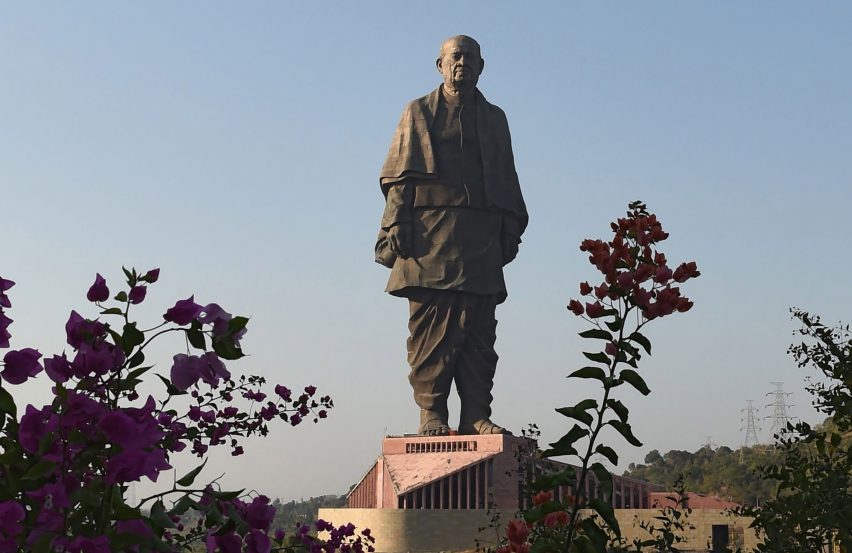
India unveils world's tallest statue
A 182-metre-high monument created by Michael Graves Architecture and Design, which is four times the size of the Statue of Liberty, has been officially inaugurated in Gujarat state, India.
The Statue of Unity is nearly 50 storeys tall, and together with its three-level base measures 240 metres, making it the world's tallest statue. Designed by Indian sculptor Ram V Sutar, the statue was made from scrap metal collected from around the country and is clad in bronze that will patina over time.
The structure, which took four years to build, required a total of 210,000 cubic metres of cement, 25,000 tonnes of steel and 1,700 tonnes of bronze and cost 29.8 billion rupees (£314 million), estimated the Guardian.
Lifts going up to a 153-metre-high viewing platform will be able to transport up to 15,000 tourists a day when the attraction opens on 3 November 2018.
View this post on Instagram
The towering sculpture depicts founding father of the Republic of India, Sardar Vallabhbhai Patel.
Patel, who was born in Gujarat, was a key player in India's struggle for independence and instrumental in uniting it as one nation after the country freed itself from British colonial rule in 1947.
"As you can imagine with a project of this scale and level of complexity, there were several challenges to overcome," James Wisniewski, principal of Michael Graves Architecture & Design and project leader on the Statue of Unity told Dezeen.
"One of the challenges was to create the statue in the walking pose while balancing the programmatic layout and function of the building’s core and structure. Luckily, Sardar Patel wore a traditional Indian dhoti of draped fabric, which allowed our team to design the elevator towers in a staggered fashion while giving the proper external appearance," he added.
"However, with sandal-clad feet and exposed ankles, the statue is thinner at the base than at upper levels, the opposite of what is typically done."
View this post on Instagram
Two reinforced concrete cores containing the lifts form the centre of the statue, with two mass dampeners at chest height to control the sway in high winds and protect the statue during earthquakes.
A steel space frame is attached to this core, from which the 22,000 square metres of individually formed bronze panels creating the sculpture's shape were hung. The sculpture's "skin" weighs over 2,000 tons.
Along with the world's tallest statue, the complex includes an exhibition hall in the base of the statue topped by a memorial garden, a visitor centre and guest lodgings, a pedestrian and road bridge connecting the statue's river island to the mainland, and a 2 mile road to the town of Kevadia.
"Part of the innovations of this project included the dynamic design and installation process which in essence celebrated the unity of India," said Wisniewski.
Scrap iron was collected from around the country, in reference to Patel's nickname of India's "Iron Man". Earth was also collected from all the country's states and districts to form a rammed earth wall backdrop to the flag, and the base, visitor centre and landscaping uses locally quarried stone.
Speaking at the opening on 31 October 2018, Indian prime minister Narendra Modi said the statue was a rebuttal to those "who question the existence of India" and stood as a symbol of the country's "engineering and technical prowess".
As part of the ceremony helicopters dropped flower petals, flotillas of balloons in the tricolour of the Indian flag were launched, and Indian Air Force jets did a flypast trailing coloured orange, green and white smoke.
Protesters are claiming that the local families who were moved to make way for the monument were not compensated for the loss of land, something the Indian government denies, and that community leaders were arrested ahead of the opening.
Today is a day that will be remembered in the history of India.
No Indian will ever forget this day: PM @narendramodi pic.twitter.com/2cAbUyZrq8
— PMO India (@PMOIndia) October 31, 2018
The Statue of Unity won't hold the title of world's tallest statue for very long. A 212-metre high statue of Chhatrapati Shivaji, India's 17th century warrior king, astride a horse is planned to open in 2020 off the coast of Mumbai.
Originally the Shivaji monument was due to be just 208 metres, but the design was revised to add some extra height on when it transpired that China's Spring Temple Buddha in Henan was getting an extra pedestal added to make it 208 metres, too.
New York City's statue of Liberty, built from copper in 1886, is just 47 metres high and sits on a 46 metre base. In South Dakota a mountain carving process has been underway since 1948 to create a 172-metre sculpture of Lakota warrior chief Crazy Horse.
Photography is courtesy of Getty.